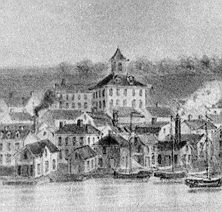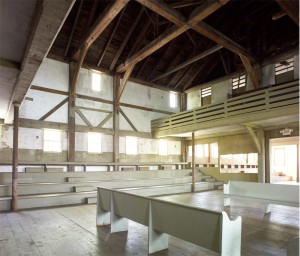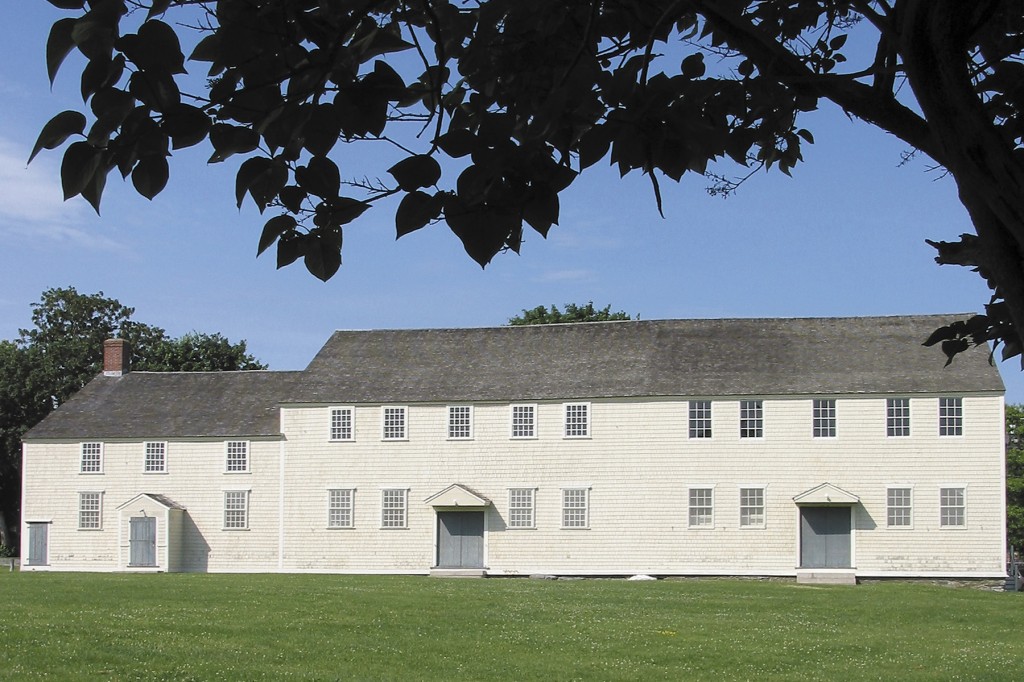The Great Friends Meeting House, built in 1699, is the oldest surviving house of worship in Rhode Island. Quakers, as they were dubbed by their detractors, were the most influential of Newport’s numerous early congregations. They dominated the political, social, and economic life of the town into the 18th century, and their “plain style” of living was reflected in Newport’s architecture, decorative arts and early landscape.
The Society of Friends was formed in the 1640s, when religious dissident George Fox began to preach the concept of the “inner light” throughout England. His beliefs spread to the colonies, and eventually to Newport aboard the ship Woodhouse, which arrived with a group of English Friends in 1657. The simplicity of Fox’s message appealed to many of Newport’s early settlers, who flocked to the Society in the 17th century. Newport’s philosophy of toleration provided a safe haven for early Quakers and here they flourished and grew
New England’s early Quakers were a persecuted lot. Perceived as a radical threat to the stability of New England society, they were whipped, driven from other colonies, and sometimes, like Mary Dyer, the well-known Newport Quaker, executed for their beliefs. These Friends disrupted Puritan services and were often perceived as witches. Their pointed hats have become part of our common folklore. Fox and his followers eventually learned to temper their actions, and in the 18th and 19th centuries, Friends became known more for pacifism, close-knit communities, and skill in business matters.
In 1660, Quakers in England directed a “testimony” to Charles II declaring their abhorrence of war. This philosophy of pacifism had an impact across the Atlantic, influencing the attitude of Rhode Island Friends toward Native Americans. In 1672, Nicholas Easton, a Newport Quaker, was elected governor of Rhode Island. The following year, Rhode Island passed the first conscientious objector law in America, which excused citizens from participation in the military if their religious beliefs forbade it. Quaker pacifist ideals encouraged neutrality and peace as policies toward Native Americans. This was especially important during King Philip’s War, an Indian uprising in 1675 and 1676 prompted by the seizing of Indian lands by Europeans, during which Rhode Island was spared the destruction that occurred in other colonies.

Upon its construction in 1699, the meeting house was the largest structure of any kind in the colonies between Boston and New York, and served as host to the New England Yearly Meeting of Friends until 1905.
The use of the grounds of the Friends Meeting House by Europeans began in 1639 with the construction of Nicholas Easton’s house, facing Farewell Street, and other necessary barns, stables, and outbuildings. Easton’s first house burned in 1641, but he built another, which he bequeathed to Newport’s Friends upon his death in 1676. This house probably became the Friends’ first permanent place of worship. In 1677, the Quakers recorded that William Allen and Patience Beer were married “at our publick meeting house in Newport.”
The Society of Friends was already well-established in this area of town when they constructed their new meeting house in 1699, which they set back from Nicholas Easton’s former house on Farewell Street. Records from the Society of Friends indicate that the old meeting house was being used for a stable until 1708, but by 1710 it was gone. In that year, Samuel Easton petitioned the Quakers for permission to build a shop “where the old meeting house stood.”
Great Friends Meeting House, ca. 1740, NHS 01.935
The meeting house the Friends constructed in 1699 was a reflection of their status within the Newport community. During the first few decades of the eighteenth century, it was largest and most recognizable building in town, and throughout the 1700s it appeared as a landmark in maps and painted landscapes of Newport. From its original square shape with a hip roof and cupola, the meeting house grew to meet the needs of the growing Society.
In 1705 and 1729, the building was expanded, according to the congregations’ minutes, “for the conveniency of the women’s meeting.” Despite the decline of Quakerism in Newport after the American Revolution, in 1807, 1857, and 1867, additions were constructed to accommodate the New England Yearly Meeting, which brought thousands of Quakers from all over the region to Newport to discuss theology, peaceful alternatives to war, and the abolition of slavery.
The Society of Friends believed in a “plain style” of living. This was reflected in the way they dressed, the way they spoke, the homes where they lived, and the meeting houses in which they worshiped.

The central cubical block of the elongated building, with its massive exposed framing timbers, tiered bench seating, and diamond pane leaded windows, is a rare surviving example of the late medieval form.
Quaker worship meetings were silent and contemplative, with each participant “centering down” to find the “Inner Light” that would allow them to communicate on an individual level with God. Only then might a Quaker rise in meeting to share this experience with the assembled worshipers. Adornments like pulpits, statuary, steeples, and stained glass were unnecessary distractions in achieving these goals.
In the eighteenth century, the grounds adjacent to the Friends Meeting House were extensively used. Ezra Stiles’s map of 1758 shows three houses of two stories, one house of 22 stories, and three shops, stables, or other businesses, all on Farewell Street, Marlborough Street, and Tanner Street (present-day Marcus Wheatland Boulevard), surrounding the Friends Meeting House. A sampling of the accounts of the Proprietors of Easton’s Point indicates that the Quakers encouraged use of the grounds, and even benefited from it. On June 20, 1770, Jonathan Nichols paid twelve pounds “for a lot in ye meeting house field”; on June 20, 1770, Ruth Goddard paid fifty-eight pounds for “her half of part of ye meeting house field”; and on November 19, 1770, Benjamin James paid eight pounds for rent of Quaker land “for a house lot by ye meeting house.” Research archaeological excavations revealed the remains of an extensive stable and an encampment used by the Hessians or French during the American Revolution.
After the departure of the New England Yearly Meeting of Friends in 1905, the building was used as a recreation center. It became an important meeting place for the African-American community and it was here that the Martin Luther King Center, a social service agency now located nearby, was founded. In the 1970s, the meeting house was restored under the guidance of architect Orin M. Bullock, and was presented to the Newport Historical Society by its owner, Mrs. Sydney L. Wright.

